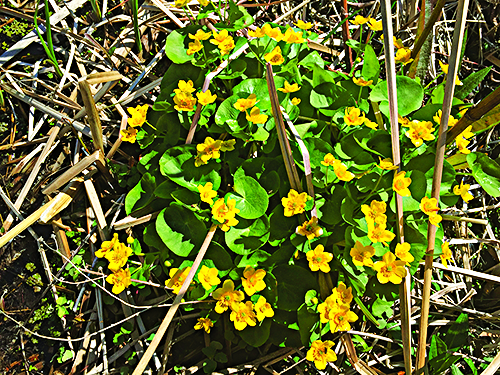When southerly March winds bring blue skies and warmer temperatures, nature lovers get an itch to explore the unfolding of spring. These rare and beautiful days are contrasted by what we normally experience in March — windy, cold and overcast days. Yet the sun will shine and spring is on the horizon.
There is much to uplift the soul in the March landscape. Vast flocks of Snow Geese migrate through Emiquon Preserve in Fulton County (Link to past article on Emiquon). The first spring ephemeral wildflowers burst from the leaf-strewn forest floor on the warm days of March (Link to past article on spring wildflowers). The unique plant called Skunk Cabbage is even more impatient and has been blooming in its marshy abode for a couple of weeks by the time March arrives (Link to past article on Skunk Cabbage). If you happen to miss seeing the Skunk Cabbage, don’t fret. There is more to discover in these wetlands.

Marsh Marigold (Caltha palustris) growing in the wetland seep at Dixon Waterfowl Refuge in Putnam County.
MIKE MILLER
In wetland seeps and springs along the Illinois River, March is prime time for spectacular displays of Marsh Marigold (Caltha palustris). They grow in wet habitats in which groundwater springs feed into streams and rivers. Locally, Bennett’s Terraqueous Gardens Nature Preserve in East Peoria is an easy location to visit these beauties. Their bright green leaves and brilliant yellow flowers cover the waterlogged soils. The lushness of their vibrant growth is contrasted by the dead stalks of other plants left over from last year. Marsh Marigold serves as a poster child for renewal and promises of a new spring.
Marsh Marigold is very particular in the types of areas where it is found. If the hydrology of the wetland is altered, it will die. In this it shares a common trait with its habitat partner, Skunk Cabbage. When they are present, they are good indicators of a healthy wetland habitat. Marsh Marigold is also used in wetland restorations as a good indicator of the health of the renewed wetlands. It serves as an indicator species for wetland ecologists to know if they are on the right track.
Marsh Marigold’s early flowers are an important nectar source for many insects including bees and flies. One interesting visitor is the Giant Bee Fly (Bombylius major). This is a fly that mimics bees. While it visits the flowers for nectar, it will size up the competition of the bees that are also seeking nectar. It is searching for a suitable bee to follow. It will track the bee to see if it is going to lay eggs. If the bee is unaware that it is being followed and deposits eggs, the bee fly will lay its own eggs in the same location. The larvae of the Giant Bee Fly will then consume the larvae of the host bee. This nest parasitism is a stark reminder that life in the natural world is filled with challenges.
While it has the name “Marsh Marigold” this plant isn’t really a marigold at all. It is actually in the buttercup family. There are several species of buttercups that bloom in various habitats in the spring. There is also a non-native species that is very similar known as Lesser Celandine or Fig Buttercup (Ranunculus ficaria). This plant can be quite invasive and very difficult to eradicate once it invades marshes. While it is more common in eastern states, it has been found growing in the Midwest, including several locations in Illinois. So, beware of the “Marsh Marigold” you might find being sold in garden centers. It could be a look-a-like that can cause real problems in our native wetlands.


Recent Comments